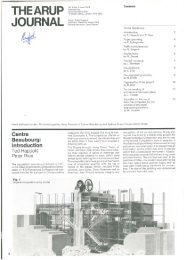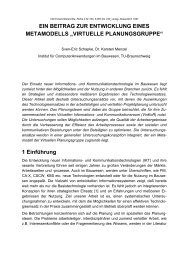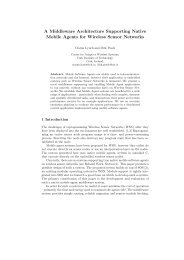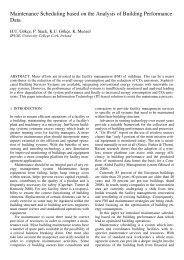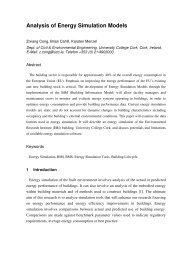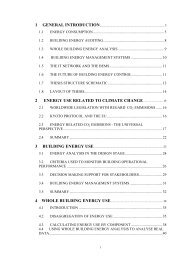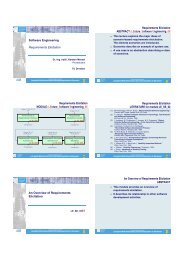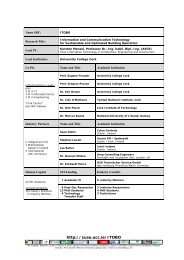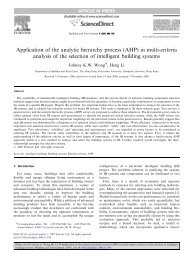Model-based virtual sensors for room heat metering and energy ...
Model-based virtual sensors for room heat metering and energy ...
Model-based virtual sensors for room heat metering and energy ...
Create successful ePaper yourself
Turn your PDF publications into a flip-book with our unique Google optimized e-Paper software.
Then, is a measurement of the building’s actual active <strong>heat</strong>ing capacity, i.e. if representsthe <strong>room</strong>’s underfloor <strong>heat</strong>ing circuits size then is the actual size of active circuits in time stepk. As is defined as the <strong>room</strong>’s <strong>heat</strong>ing capacity in relation to other <strong>room</strong>s, eq. (2) also allows toestimate the percentual share of a <strong>room</strong> in the overall <strong>heat</strong> flow from eq. (1) such that finally results · . (3) This equation (3) allows estimating the <strong>room</strong> <strong>heat</strong> flow from the relative <strong>heat</strong>ing capacity of a<strong>room</strong> in comparison to the others. In the named example of using the underfloor <strong>heat</strong>ing circuit size as it will mean that a <strong>room</strong> utilises the same proportion of the actual <strong>heat</strong> flow as his <strong>heat</strong>ing circuitsize is in relation to the building’s active circuits . The benefit of equation (3) is that it easilyscales to different available knowledge levels by modelling <strong>and</strong> adequately.The valve opening depends on the control values computed by the <strong>room</strong> temperaturecontroller. If a detailed model is necessary then the specific characteristic curves of the valves can beused. In case of the ERI, simple on/off-valves are used <strong>and</strong> it can be simplified that 0, 1.The relative <strong>heat</strong>ing coefficient of each <strong>room</strong> can be individually adapted to the availablein<strong>for</strong>mation about the building. In simple cases it can be set to the number of valves or radiators,which permits rough estimations. Better results provide the size of the underfloor <strong>heat</strong>ing system orradiators assuming that their size is proportional their <strong>heat</strong>ing capacity. For very precise results,detailed models of the <strong>heat</strong>ing system systems can be used that model also dynamic aspects such asthe dependence of the <strong>heat</strong> transfer on the temperature difference between the <strong>heat</strong>ing system <strong>and</strong><strong>room</strong> air temperature.The estimation in its basic <strong>for</strong>m in eq. (3) neglects any time delay behaviour in the <strong>heat</strong>ing systemsuch as the dead times of the water floating through the pipes as well as the delay behaviour of the<strong>heat</strong> transfer between the underfloor <strong>and</strong> the <strong>room</strong> air temperature. It assumes that the delay effectsare less relevant <strong>for</strong> the estimation considering the fact that large sampling intervals of 15 min arecommon in building per<strong>for</strong>mance analysis like in the ERI case. If the delay times are very large <strong>and</strong>not neglectable the equation (3) can be extended to an difference equation considering also pastcoefficients with <strong>and</strong> .Summarising, a buildings <strong>room</strong>’s <strong>heat</strong>ing consumption can be estimated in each time step by the following algorithm:(1) Compute the <strong>room</strong>’s control value <strong>and</strong> valve opening <strong>for</strong> each <strong>room</strong> .(2) Compute the building’s actual <strong>heat</strong>ing coefficient with eq. (2) from .(3) Estimate the <strong>room</strong>’s <strong>heat</strong> flow <strong>for</strong> each <strong>room</strong> via eq. (3) from , .The proposed algorithm uses the control value <strong>for</strong> each <strong>room</strong>’s individual <strong>heat</strong>ing control. Asin<strong>for</strong>mation about the control value is often not available like in the investigated ERI case, the controlvalue can also be computed by remodelling the control algorithm. In case of the ERI, the valvesare individually controlled <strong>for</strong> each <strong>room</strong> by a bounce control with a hysteresis of 0.3Cº arounda temperature set-point . This means, that if the temperature in a <strong>room</strong> drops below ( - ) the valves are opened ( 1) <strong>and</strong> the <strong>room</strong> is <strong>heat</strong>ed until the <strong>room</strong> temperaturereaches ( + ) at which point the valves are closed ( 0). Thus,1, ; 0, ; (4) 1, otherwise.If more advanced PID controllers are used the control value can be recomputed in a comparableway if the controller parameters are known. If the set-point is not known it partly can bereconstructed from the step response of the <strong>room</strong> temperature (Vasyutynskyy, V. et al., 2005) if thequality of control is good enough.




